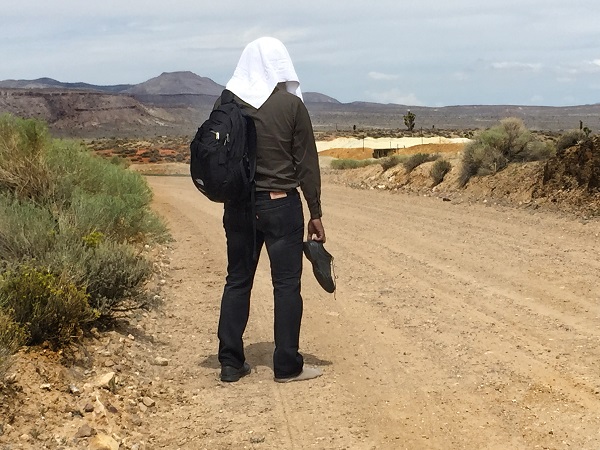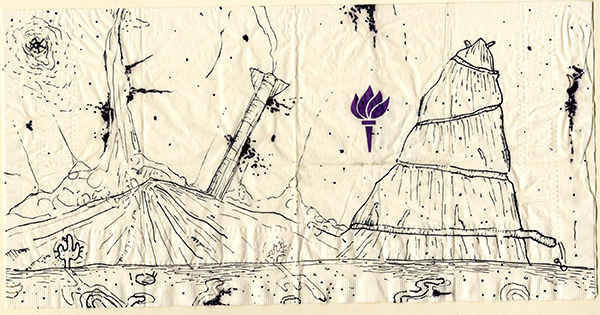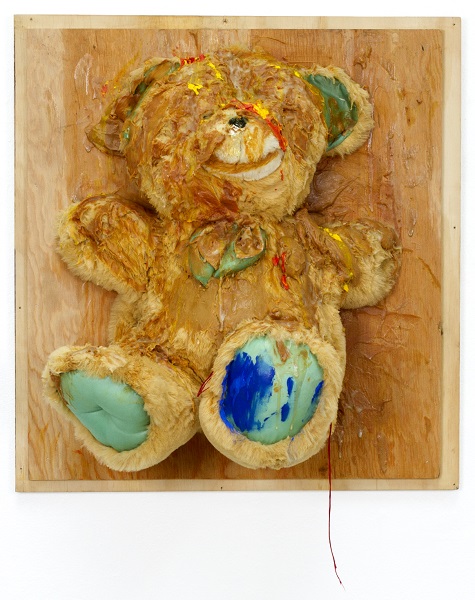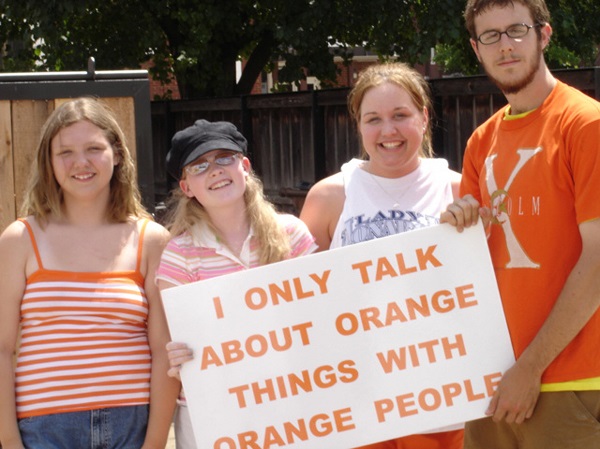
Obi Sunt (Production Image from the making of Obi Sunt), 2015, William Pope.L. Courtesy of the Artist © Pope.L
“Artists don’t make art, they make conversation. They make things happen. They change the world” —William Pope.L
William Pope.L has a prolific and polymorphous multi-media art practice. In addition to his well-known performances, he creates sculpture, installation, drawings, paintings, photography, video, and writing. With seemingly inextinguishable curiosity and boundless appetite, Pope.L absorbs every possible medium and explores the many themes that are important to him with drollery, poetry, and a unique, irreverent, inquisitive, and highly personal point of view. He once described himself as “a fisherman of social absurdity.”
Pope.L has exhibited widely in the United States and internationally; most recently, his work was on view in a large-scale exhibition at the Museum of Contemporary Art entitled Trinket, in which a giant fraying American flag mesmerized viewers. He will be back in Southern California this year for two companion exhibitions, Desert at Steve Turner and Forest at Susanne Vielmetter Projects, and to give a keynote address at FAR-SITED, a conference on public art co-organized by the Getty Conservation Institute, the University Art Museum at California State University Long Beach, and the Museum of Latin American Art.
Pope.L took my questions from his home base in Chicago.
Tell us a bit about how and why you became an artist.
I used to blame my being an artist on my grandmother, but that was my younger self looking for a scapegoat. At one point in undergrad, I had a moment, a crisis where I thought it was my job to save my family and the best way to that was to be a commercial artist—but I had to let go of that. Truth be told, being an artist is something I choose every day. Of course, maybe I choose art because I’m afraid of theater—too much memorizing and being in the moment and shit.

Failure Drawing #301, NYU/Napkin, Rocket Crash, William Pope.L. Courtesy of the Artist © Pope.L
You have an extremely broad artistic practice that encompasses performances, installations, paintings, drawings, writing, videos…your work resists categories. How do you think of it and describe it?
I think my practice does not resist categories so much as invite them in—it’s a shameless, big-bottomed oeuvre.
Your work tackles important social and racial issues, but also includes the seemingly mundane and commonplace. For example in your recent show at MOCA, Trinket, a giant American flag cohabitated with hundreds of onions. How does it all connect?
How does it all connect? I have no idea. Perhaps finally when all is said and said is done we’re just dung heaps on top of dung heaps on top of dung heaps—I’m not sure…
In your performance work, your own body becomes part of the art. Is there a feeling of being exposed, vulnerable, or at risk?
I think risk in art performance can be a good or a bad thing. Good in that one is pushing the form. Gratuitous in that that might be the only thing one is doing.
You’ve commented on the power bestowed upon objects in our consumerist society, drawing a parallel with the power of objects in some forms of magic, animism, and voodoo. How do you view the place of objects in our society?
I believe our contemporary relationship to objects is real enough. It’s about engaging in a fantasy of control of our environment, our DUSTINY. At bottom it’s not far from micturating into a bowl, stirring it with blood and herbs and slugging it down because we think, somehow, it will improve our lot.
A lot of your work deals with racial issues—perceptions of “blackness,” “whiteness,” the absurdity of racial prejudices, the violence of it. Why do you address race in your work? Do you think art can be an agent of change?
I address race in my work ‘cause day-to-day in our country it addresses me. Yes, art can change the world but so can Disney—so there is that. I think the real question is not can art change the world, but can art be changed by the world? Would we allow this?

Gans-Nelson fight, from the album ‘Incident to the Gans-Nelson fight’ (Page 40-3), Goldfield, NV, September 3, 1906, William Pope.L. Courtesy of Steve Turner and the Artist
The magazine Artforum published your work Foraging (Asphyxia Version)—a photograph of a performance in which you have your head in a plastic bag—on its cover in connection with an article on Eric Garner’s death. How did you feel about this use of your work?
I’ve gone on record already in several different instances re: my feelings toward how Artforum dealt with using my work to speak about Eric Garner’s death—it was bold, smart, hip and well-meaning. They thought they were doing the right thing. I thought they could have done smarter, bolder things. Things I’d seen them do before with white artists—like a forum of writers speaking out—they could have created a community event around the issue [so that] artists might represent the waste of so many young black men killed by other men, many white, some black—men who could be these boys’ fathers and brothers, and who supposedly our society pays to protect them.
Humor, with a touch of the absurd, seems to be an important component in your artistic practice. What role does humor play in your work?
I like to use humor in my work ‘cause it answers/deals with questions in ways that are very unique. Humor answers questions with an immediacy and creates a productive amnesia of the moment in the receiver—but then the wave recedes, the world floods back in with its pain, confusions, and crush but the humor remains like a perfume or an echo or a kiss inside beneath one’s skin.

Trophy (Big Bear with Blue Feet), 2007, William Pope.L. Courtesy of the Artist © Pope.L
You are also an educator, teaching in the visual arts department at the University of Chicago. How do your teaching and artistic practices complement each other?
Teaching is my job. I pay my mortgage with it. I cannot do this with my art.
On October 16th you’re giving a keynote address at FAR-SITED, a conference in Long Beach on the topic of public art. Your work has taken place in public spaces and used symbols of public consciousness, such as the U.S. flag. Do you perceive your work as public art? Does the public have a role to play in your work?
Does the public have a role to play in my art? I guess it’s according to what is meant by “the public.” If what is meant is people in general—I’d say fucking A! I hope so! But usually when an artist says this, most times he or she is thinking: fans. But users are choosers and they decide how they want to consume the world, not the artist. So inviting folks into your art, your world of art is fraught with uncertainty. But I believe to enrich the work, the risk is necessary. This is something I’ve tried to make room for—most specifically in the Black Factory Project. But I believe overall I’ve tried to make way for a public in conceiving and making my work—for me it’s part of the crafting of the work [in] that it takes into account a receiver out there in the world who I might not know personally.

Tour People, 2005, William Pope.L. Courtesy of the Artist © Pope.L
Do you ever think about the conservation of your work—will it endure, can it be recreated? Or is it your art for this time only?
Does my work exist for this time only? Probably, maybe, I don’t know—yes, whether I like it or not. I’m lucky. Many artists would love to have their work exist for this time only. My big problem in answering this question, in a straightforward way, is that I sometimes believe in god. Sometimes I even believe in god when I make art. So—I ask myself: During the episodes when I’m making art and believing in a being that exists outside of human time, does my art also exist outside of human time? But then I ask myself: If your art doesn’t exist for its own time, then what time does it exist for?
What are your main upcoming projects?
The main upcoming project I’m looking forward to is a nap.
William Pope.L and Rachel Rivenc speak at FAR-SITED: Creating & Conserving Art in Public Spaces, a public conference taking place in Long Beach on October 16, 17, and 18, 2015. Pope.L delivers the keynote address on October 16 at 6:00 pm. The event brings together artists, conservators, scientists, students, and arts leaders to discuss pressing issues of creating, displaying, and conserving art for public spaces.
Text of this post © J. Paul Getty Trust. All rights reserved.




Comments on this post are now closed.